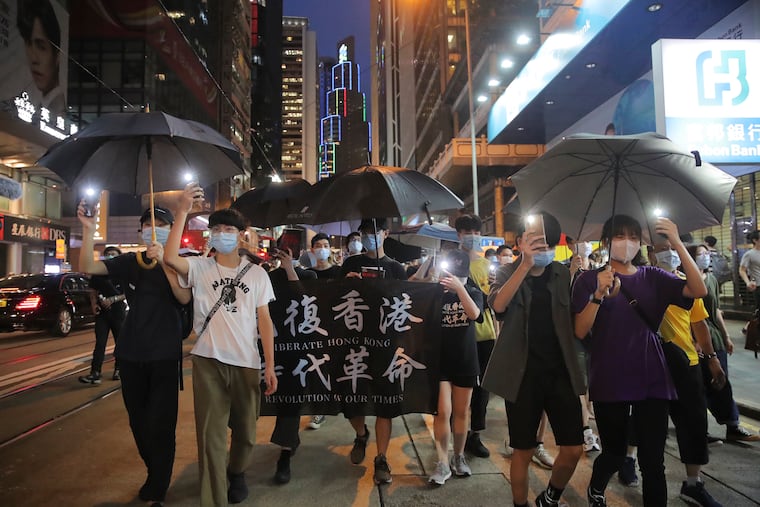George Floyd’s death sparked a U.S. movement. Are there lessons from Tahrir Square and Hong Kong? | Trudy Rubin
Pay attention to what happened in Cairo and Hong Kong when they demonstrated for freedoms and against police violence.

As I watched youthful demonstrators pour into Philadelphia streets to protest police violence and the murder of George Floyd, I couldn’t help recalling the past protests for justice I’d witnessed overseas.
From “people power” in the Philippines in 1986, to the Eastern European revolts against Soviet rule in the late-1980s; from mass protests against Kremlin repression in Moscow over the past three decades to the popular ouster of a Kremlin clone in Kyiv in 2014; from the Arab Spring rebellions, to the French Yellow Vest upheavals, to the pro-democracy protests in Hong Kong: I watched individuals express outrage over arrogant rulers, police repression, official corruption, and indifference to the will of their people.
Of course, comparisons with the current U.S. protests have severe limits. In most of these revolts, the aim was to topple oppressive rulers or systems at a historic moment when these regimes had weakened.
» READ MORE: Live coverage of Tuesday's protests: Mayor Kenney promises police reform
But despite the many cultural, historical, and political differences, two of these revolts haunted my thinking over the past week. Both of them were organized by young activists via social media: first, the Tahrir Square rebellion in Egypt that began in 2011, and second, the ongoing protests in Hong Kong.
The Egyptian revolt, in one obvious comparison, was sparked in 2011, when police beat to death a 28-year-old blogger named Khaled Said, who had been protesting police corruption in Alexandria.
Brilliant organizing tactics by a group of young Egyptian techies via Facebook — including a memorial page called “We are all Khaled Said” — led to the peaceful toppling of President Hosni Mubarak.
It was fascinating to watch how these young leaders mapped out a strategy to disperse police forces and coax Cairenes from working- and upper-class districts to join marches. They used this moment to unite Egyptians fed up with regime corruption and nepotism, rising food prices, and heavy-handed behavior by police for which citizens had no recourse.
» READ MORE: U.S. must stand with Hong Kong against Beijing's efforts to crush its freedoms | Trudy Rubin
And it was astonishing to watch Egyptians of different classes, educations, religions, and skin colors march beside each other by the tens of thousands into Tahrir Square in the name of dignity and justice. I will never forget a taxi driver telling me he had felt like “a donkey” before the upheaval, but standing with fellow Egyptians, he finally felt proud to be an Egyptian.
Yet, the Tahrir Square revolution failed, and Egyptians are now ruled by a military dictator, President Abdel Fattah el-Sisi, who is worse than Mubarak. And the young leaders of Tahrir Square are either in jail, in exile, or trying to keep out of sight.
Several of the revolt’s leaders told me their biggest weakness was their inability to translate their organizing skills into political impact. They were unwilling or unable to organize the poor and less educated in rural and urban Egypt into a movement.
Instead of uniting behind one presidential candidate, they split their support between several, which enabled the Muslim Brotherhood candidate, Mohamed Morsi, to narrowly win the presidency in 2012. One 25-year-old leader later told me, over coffee in the legendary intellectuals’ Café Riche in Cairo, “The Muslim Brotherhood succeeded in reaching power because of liberals’ mistakes.”
When Morsi became repressive, young activists again tried to unseat his government with a massive demonstration, gathering hundreds of thousands of signatures demanding his ouster. Again, they failed to organize those signatories into a political movement. Military officials took advantage of public weariness with continued upheavals and staged a coup.
In Hong Kong, the protests also revolved around police violence and legal injustice. The spark was Beijing’s attempt to curb the independence of the territory’s courts, which operate under a “one country, two systems” framework. This system allows Hong Kong to maintain freedoms (until 2047) that are denied to Chinese on the mainland, including the right to assembly and limited suffrage.
» READ MORE: Three years later, the hope of Tahrir Square is gone | Trudy Rubin
Under pressure from Beijing, the Hong Kong police cracked down hard on the protests, with thousands of arrests along with beatings. Protesters then demanded an investigation into police brutality, along with long-promised universal suffrage. But a minority of angry young people also began using violence, smashing stores whose owners were sympathetic to Beijing and throwing Molotov cocktails at police cars.
Falsely tarring all demonstrators as violent, and aided by the shutdown during COVID-19, Beijing has now endorsed draconian security legislation that will expose Hong Kong demonstrators to serious punishment. “One country, two systems” is almost dead.
Again, the context and politics in Cairo and Hong Kong are very different from the protests here. Yet, when I think of what young people achieved and lost in Cairo and Hong Kong, here’s what comes to my mind: The Egyptian tragedy reminds us of the need for focused, coherent political demands, with as much unity as possible, at a historical moment when a nation is open to change.
And the Hong Kong struggle should remind us that our flawed and stressed system — which supposedly includes universal suffrage (if we can keep it) — still holds out the possibility of change, including an overhaul of policing.
We are not Egypt or Hong Kong, and this is the moment to prove we are still the United States.